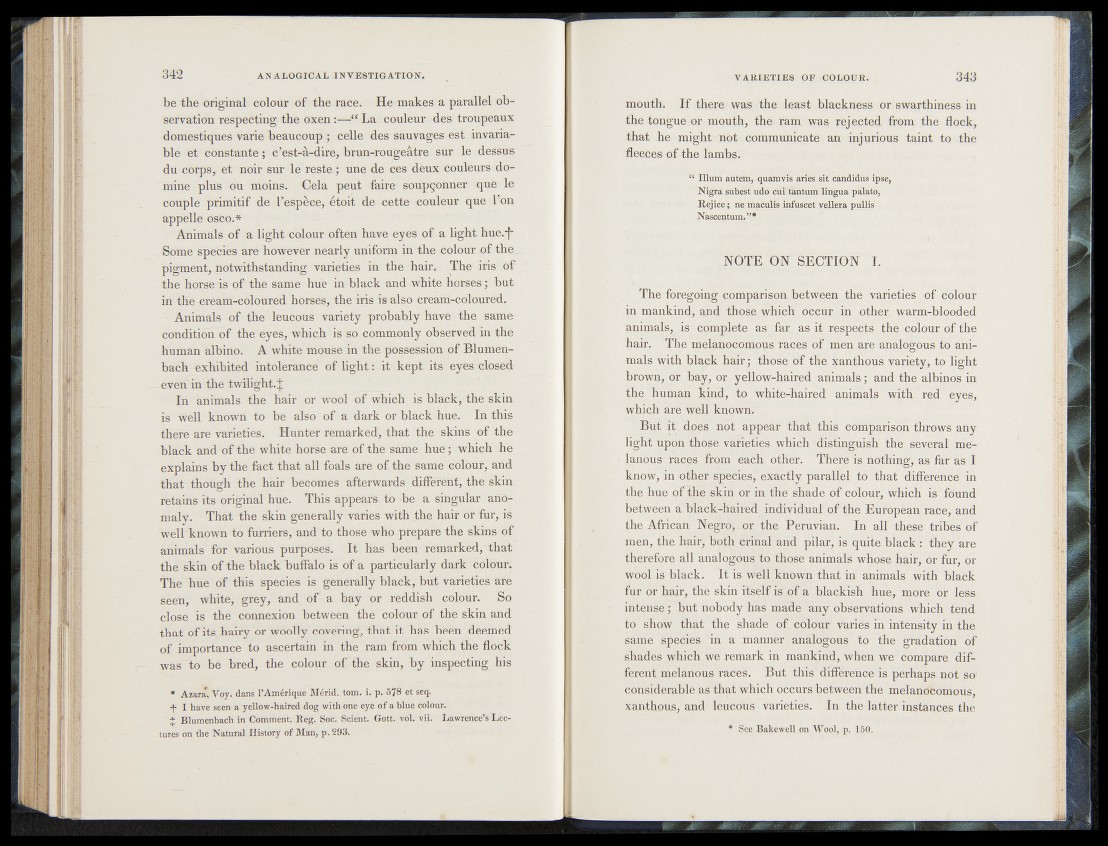
be the original colour of the race. He makes a parallel observation
respecting the oxen La couleur des troupeaux
domestiques varie beaucoup ; celle des sauvages est invariable
dt constante; c’est-à-dire, brun-rougeâtre sur le dessus
du corps, et nbir sur le resté ; une de çes deux couleurs domine
plus oii moins. Cela peut faire soupçonner que le
couple primitif de l’espèce, étoit de cette couleur que l’on
appelle oseoi*
Animais of a light colour often have eyes of a light h u e ^
Some species are however nearly uniform in the colour of the.
pigment, notwithstanding varieties in the hair. The iris of
the horseus of the same hue in black and white horses ; but
in the ereatn^coloured horses, the his is also ereaih-çOlbured.
Animals of the leucous variety probably hâve the same
condition of the eyes, which is so commonly observed in the
human albino. A white mouse in the possession of Blumen-
bach exhibited intolerance of light i it- kept its eyes closed
-èvenTin the twilight.^
In animals the hair or wool of which is black, the skin
is well known to be also of a dark of black hue. In this
there are varieties. Hunter remarked, that the skins of the
black and of the white horse are of the same hue; which he
explains by the fact that all foals are of the same colour, and
that though the hair becomes afterwards diffèrent, the skin
retains its original hue. This appears to -be a singular anomaly.
That the skin generally varies with the hair or fur, is
'well known to furriers, and to those who prepare the skins of
animals for various purposes. It has been remarked, that
the skin of the black buffalo is of a particularly dark colour.
The hue of this species is generally black, but varieties are
seen, white, grèy, and of a bay or reddish colour. So
close, is the connexion between the colour of the skin and
that of its. hairy or woolly covering, that it has been deemed
of importance to ascertain in the ram from which the flock
was to be bred, the colour of The skin, by inspecting his
* Azara, Voy. dans l’Amérique Mérid. tom. i. p. 578 et seq.
+ I have seen a yellow-haired dog with one eyè o f a blue colour.
+ Blumenhach in Comment. Keg. Soc. Scient. Gott. vol. vii. Lawrence’s Lectures
on the Natural History of Man, p. 293.
mouth. I f there was the least blackness or swarthiness in
the tongue-oMaouth, the ram was rejected from the flock,
that hei|fi|igh,t not communicate an injurious taint to the
fleeces of the lambs.
“ Ilium autem, quamvis aries sit candidus ipse,
. Nigra subest udo cubtantum lingua palato,
- Rejice; ne maculis infuscet vellera pullis
Naseentum.’**
NOTE 0 ^ ;S E C T I0N I.
The foregoing comparison between thp varieties of colour
in mankind, and those which voccur in -other, warm-blooded
animals, is complete as far, as it respect^„ the colour of the
hair. The meiahocomous races' of men are analogous to animals
with black hair; those of the xanthous variety, to light
brown, or, bay, or yellow-haired f animals; and,the albinos in
the human kind, to white-haired animals w ith 're d ! eyes,
which are well known.*
But it dpes-not appear that this comparison throws any
light;upon thd^e varieties which ‘distinguish the several me-
fanous races from CaCh other. There is nothing, as far as I
know, in other species, exactly parallel to that difference-in
the h « o fT h e skin or in the shade of colour, Which ii^fdund
between a black-haired individual of the European race, and
the African Negm,.,or the Peruvian. In all these tribes of
men, the hair, both crinal and pilar, is quite black : th ey ‘are
therefore all analogous to those animals whose hair, or fur, or
wool fs black. It is well known that in animals with black
fur or hair, the skin itself & of a blackish hue, more or less
intense; but nobody has made any observations which tend
to show that the shade of'colour varies in intensity in the
same species in a manner analogous to the gradation Of
shades which we remark in mankind, when we compare different
melanous races. But this difference is perhaps not so1
considerable as that which occurs between the melancffcomous,
xanthous, and leucous, varieties. In the latter instances the
* See Bakewell on Wool, p. 150.